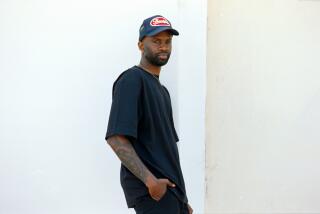Richard Wyatt’s reunion with his youthful art at UCLA Fowler Museum
All it took was one look.
The artists behind a vibrant mural depicting community protection of black youth were a mystery to the folks at UCLA. An image of the work, part of the school’s archive, would eventually grace university publications, including an edition of the museum’s newsletter Fowler Now, but they didn’t know who had painted it.
That’s when Richard Wyatt came upon it.
“The winter newsletter came in the mail one day,” recounted Wyatt, 54. “And there it was. I was like ‘Whoa! Man, that’s our mural.’ ”
The “our” refers to Wyatt and his then-”art-partner-in-crime” Guillermo Anderson. Both were commissioned -- at age 14 -- in 1971 to create the work as part of an outreach program at the school.
The oil-on-canvas work features an outstretched arm presiding over the youth in the image; in another corner is an oversized arm, acting as a shield. A pregnant woman hugging her belly is meant to represent the future.
UCLA Fowler Museum had planned to showcase the work in the exhibition “Art, Activism, Access: 40 Years of Ethnic Studies at UCLA,” on view through mid-June, and hang a sign requesting that anyone with information about the painting contact the Ralph J. Bunche Center for African American Studies. But Wyatt was one step ahead.
“I called the school up, and now I’m getting ready to see it on display again. It’s great,” Wyatt said.
UCLA’s role
“It’s really an honor because I didn’t know it was still around,” Wyatt said. “Unfortunately, a lot of the work that you do for the public fades away or gets torn down. So it’s nice that they felt proud enough to keep it. To hold on to it for so long. And to find it worthy of this exhibit.”
The exhibit, which explores the university’s role in expressing issues of underrepresented communities in America as the call for civil rights grew louder, features a display of murals, photographs, films and ephemera from campus archives.
Included are photographs from the series “Life in a Day of Black L.A.: The Way We See It,” shot in 1992 by well-known African American photographers, and a screening area with an ongoing sequence of films like “Frontierland” by Jesse Lerner and Rubén Ortiz Torres, as well as a display of posters and handbills with ties to political action.
“The goal is to celebrate the history of the study centers on the campus,” said Betsy Quick, Fowler’s director of education. “The really important contributions they made in expanding curricula, in encouraging faculty and students to become involved in political and social issues, and how they shaped increasing access of student and faculty of color. Wyatt and Anderson’s mural is representative of that.”
Productive summer
Wyatt and Anderson, who is now deceased, were just “a couple of kids from Compton who loved art,” Wyatt said. Every day that summer of 1971, they would ride the bus from Compton to Westwood. Dressed in faded jeans and tattered shirts -- “maybe even a dashiki” -- the boys would sketch and paint. Hour after hour. The “mad music and crazy comedy” of Dr. Demento on radio would serve as their soundtrack.
“We were sad when it all ended,” Wyatt said. “I mean, we were in a college environment. It was impressive to us. It really kind of established for us at that age that it was something we wanted to be a part of . . . and could be a part of.”
The 7-by-9-foot mural was in Campbell Hall outside the Bunche Center until 1991, when it was placed in storage.
And Wyatt, who would eventually receive a degree from UCLA in 1978, would meander over to admire it.
“I would come to see it every once in a while,” he says. “It’s a work that I did and you move on to the next one. But seeing it there brought back a lot of memories.”
Since his public debut, he’s exhibited widely and created numerous murals seen in Southern California and beyond, including pieces at Union Station, Long Beach City Hall and LAX. He is collaborating with artist May Sun on a commission for the Robert F. Kennedy Monument at the former Ambassador Hotel site on Wilshire Boulevard.
In April, Wyatt will take part in a Fowler on the Town tour, where he’ll discuss how the mural shaped his later work; the event will include a visit to his mural “City of Dreams/River of History” at Union Station.
“If only my 14-year-old self could see me now.”
yvonne.villarreal@latimes .com
More to Read
The biggest entertainment stories
Get our big stories about Hollywood, film, television, music, arts, culture and more right in your inbox as soon as they publish.
You may occasionally receive promotional content from the Los Angeles Times.











